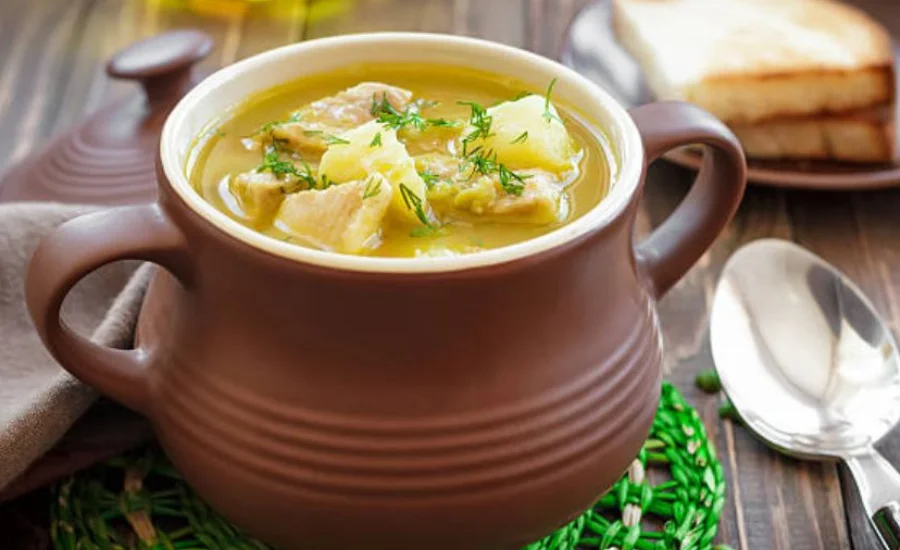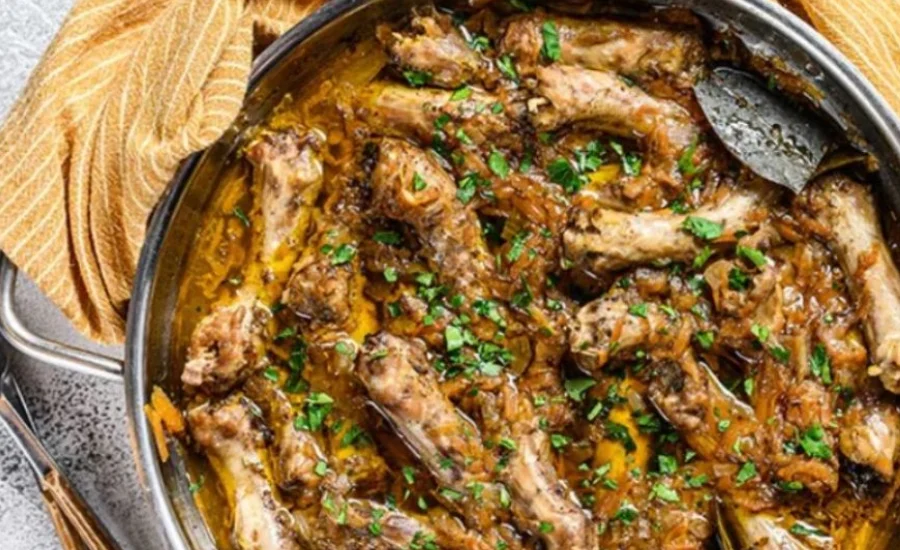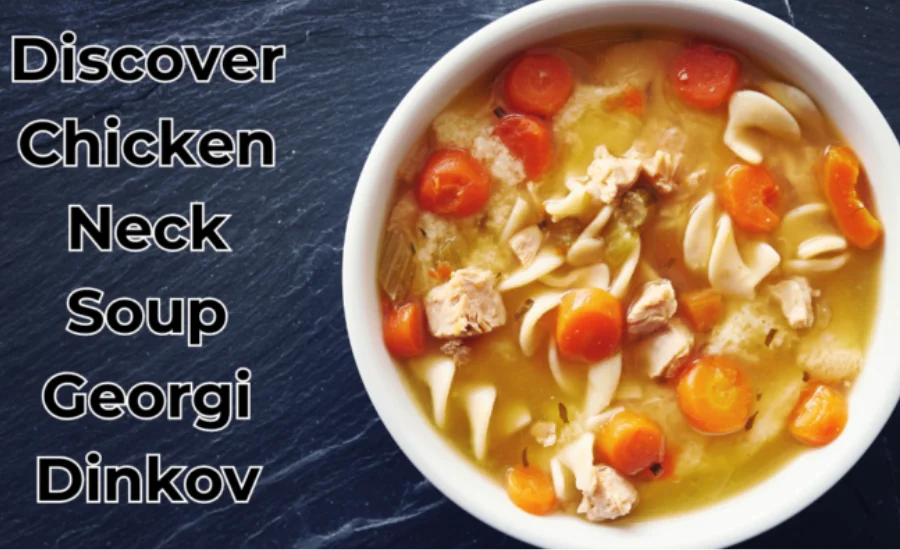Shicken Neck Soup Georgi Dinkov: Discovering, Nourishing, Vision, Health Benefits And More
Shicken Neck Soup Georgi Dinkov: Chicken neck soup is gaining widespread recognition for its comforting flavors and impressive health benefits. Health enthusiast Georgi Dinkov has recently brought more attention to this humble yet nourishing dish, praising its dense nutritional profile and its versatility in various cuisines.
Although different cultures may have their unique takes on the dish, the essence of chicken neck soup remains consistent—a hearty broth that offers both physical comfort and emotional warmth. This guide explores the soup’s rich cultural heritage, traditional preparation methods, and the numerous health advantages it brings, while also providing home cooks with tips on how to seamlessly incorporate this nutritious option into their meal plans.
Discovering the Nourishing Delights of Chicken Neck Soup
For centuries, people have loved and appreciated chicken neck soup – a classic dish cooked by boiling chicken necks with a variety of vegetables and herbs, which is rich in nutrients and taste. This method of long simmering extracts the rich flavor and nutrients from the necks, which are sometimes disregarded as an essential component. Full of nutrients, collagen, and flavor, chicken necks provide a cheap, yet incredibly nourishing, way to get all the advantages of chicken.
Even though chicken neck soup seems simple, anybody looking for a hearty, filling dinner will find comfort in its rich, delicious flavor. This meal has been enjoyed for millennia in many countries, but it has recently gained appeal, especially in the US, partly because to health advocate Georgi Dinkov.
The Vision of Georgi Dinkov
The Story Behind Georgi Dinkov
Georgi Dinkov, a culinary expert, was raised in Bulgaria, where food is closely tied to family and cultural traditions. From a young age, he developed a deep appreciation for fresh, local ingredients and the importance of home-cooked meals, influenced by his grandmother’s recipes. This early inspiration set him on a path toward culinary arts, combining traditional techniques with innovative approaches.
Dinkov’s culinary journey has spanned the globe, blending his Bulgarian heritage with modern cooking methods. His unique perspective has allowed him to reimagine classic dishes like chicken neck soup, which has garnered him attention as a forward-thinking and creative chef.
Dinkov’s Approach to Food
For Georgi Dinkov, food should not only nourish the body but also excite the senses. He emphasizes the use of simple, high-quality ingredients that elevate the natural flavors of each dish. As an advocate of farm-to-table cooking, Dinkov values locally sourced ingredients, supporting sustainability while creating fresh, flavorful meals.
Creativity remains at the heart of his culinary philosophy, encouraging home cooks to experiment with traditional recipes. His version of chicken neck soup perfectly reflects this approach, blending time-honored methods with a touch of modern flair to craft something both comforting and inventive.

The Health Benefits of Chicken Neck Soup
Chicken neck soup, as promoted by Georgi Dinkov, offers more than just delicious comfort—it is also packed with numerous health benefits. The slow-cooking process releases essential nutrients from both the chicken necks and the vegetables, resulting in a nutrient-dense broth. Here are some of the key health advantages of this nourishing soup:
- Rich in Collagen: Chicken necks contain high levels of collagen, a protein essential for maintaining healthy skin, joints, and gut health. As the soup simmers, the collagen breaks down into gelatin, which supports digestion and promotes overall gut health.
- Strengthens Bones: Chicken necks are an excellent source of calcium and phosphorus, two minerals vital for maintaining strong bones and teeth. These minerals are released into the broth during cooking, making the soup a great option for supporting bone density.
- Immune System Booster: Like other traditional chicken soups, chicken neck soup is known for its immune-boosting properties, helping to fend off colds and flu. The nutrient-rich broth supports recovery and strengthens the body’s defenses against illness.
- Affordable and Nutrient-Dense: Chicken necks are one of the most affordable cuts of meat, offering families a budget-friendly way to create a nutrient-dense, flavorful meal without sacrificing quality.
- Supports Skin and Hair Health: Thanks to its high collagen content, chicken neck soup also benefits the skin, hair, and nails, making it a popular choice for those seeking anti-aging and beauty-enhancing nutrients.
Georgi Dinkov’s Tips for the Perfect Chicken Neck Soup
When preparing chicken neck soup, Georgi Dinkov emphasizes several key steps to achieve the best possible results. Here are his expert tips:
- Start with Quality Ingredients: Using fresh, organic chicken necks will provide the best flavor and nutritional benefits. Purchase from trusted sources and pair them with fresh vegetables and herbs to build a well-rounded, flavorful broth.
- Slow Cooking for Maximum Flavor: Patience is key when preparing chicken neck soup. Simmering the broth slowly for one to two hours allows the flavors to fully develop, creating a rich, deep taste that fast cooking methods can’t replicate.
- Season to Taste: Taste the soup as it cooks, adjusting the seasoning along the way. Georgi Dinkov suggests finishing the dish with a squeeze of lemon or fresh herbs to brighten the flavors and add a final layer of complexity.
- Enjoy the Process: Take time to enjoy the aromas and the meditative process of creating a hearty meal from simple ingredients.
Step-by-Step Guide to Chicken Neck Soup by Georgi Dinkov
To recreate Georgi Dinkov’s beloved chicken neck soup at home, follow these easy steps:
- Preparation: Start by rinsing the chicken necks under cold water. Chop onions, garlic, carrots, and celery into even pieces to ensure a balanced flavor.
- Sautéing: Heat a tablespoon of olive oil in a large pot and sauté the onions and garlic until translucent. This creates a base for the soup’s flavor.
- Browning the Chicken Necks: Add the chicken necks to the pot and brown them for about five minutes to deepen the flavor of the broth.
- Simmering: Add the chopped vegetables and herbs, then pour in enough water to cover the ingredients. Bring the soup to a boil, reduce the heat, and simmer for one and a half to two hours. The long cooking time helps extract the nutrients and flavors from the chicken necks.
- Straining and Serving: Once the soup has simmered, strain the broth to remove the solids, leaving behind a rich, flavorful soup. Serve with fresh herbs or a lemon wedge for added brightness.
Variations and Serving Suggestions
Although Georgi Dinkov’s rendition of chicken neck soup is exceptional, there are other ways to personalize the meal to fit different preferences. Regional variants give distinctive takes on the traditional broth; examples include the use of dill in Eastern European recipes or ginger and garlic in Asian ones.
If you’re on a plant-based diet, you can still make a rich and savory broth without any meat by modifying the recipe to use veggies like miso paste and mushrooms.
Serve the soup with fresh salad or crusty bread to improve the eating experience. The tastes can also be enhanced with a glass of fresh white wine, giving the dinner a sophisticated yet cozy vibe.
Why Choose Chicken Neck Soup?
Chicken neck soup is a great complement to any meal plan since it offers a satisfying combination of tastes and health advantages. The strong mineral composition of the soup helps to build bones, and its high collagen level promotes joint health. Beyond its nutritional worth, this meal embodies Georgi Dinkov’s concept of simple yet nutritious food, offering comfort and satisfaction with every bite.

Common Pitfalls to Avoid When Crafting Chicken Neck Soup
Georgi Dinkov’s delicious chicken neck soup calls for meticulous attention to detail in order to maximize taste and texture. Rushing the cooking procedure is one of the most frequent errors. Even while it might be tempting to move more quickly, a moderate simmer is the best way to bring out the taste of chicken necks. Aimlessly boiling them might produce rough meat and a murky soup. To produce the deep, rich flavors that are typical of this meal, one must be patient.
Another frequent error is inadequate seasoning. Many cooks tend to season their soups right before serving, but gradually adding salt and spices throughout the cooking process yields superior results. This method allows the flavors to meld beautifully. It’s wise to taste the broth regularly and adjust the seasoning as needed; starting with a small amount of salt is advisable, as it’s easier to add more than to correct an over-seasoned soup.
The final result is also greatly influenced by the quality of the components. The overall flavor of the soup might be significantly impacted by using inferior chicken necks or canned veggies. Select fresh, organic foods wherever feasible. The taste of the finished meal is greatly influenced by the quality of the individual ingredients.
Finally, always strain the soup before serving. Straining helps eliminate any particles or impurities that could alter the soup’s consistency. By avoiding these common pitfalls, you can create a flavorful and satisfying chicken neck soup that reflects the essence of Georgi Dinkov’s culinary expertise.
The Cultural Heritage and Importance of Chicken Neck Soup
Chicken neck soup boasts a rich history that showcases the resourcefulness of home cooks throughout the ages. Historically, utilizing every part of the bird, including the neck, was a sensible way to minimize waste. This practice is celebrated across various cultures, where culinary creativity is highly valued. Culinary expert Georgi Dinkov emphasizes the delicious and nourishing qualities of chicken necks, modernizing this traditional dish while honoring its roots.
Many cultures hold soups made from different chicken parts in high regard. For example, in Eastern Europe, chicken soup is a staple at family gatherings and special occasions, symbolizing comfort and nourishment. Dinkov’s recipe highlights how simple ingredients can come together to create a hearty meal, bridging generational cooking practices with contemporary methods.
Furthermore, chicken neck soup is often considered a therapeutic food. Many believe the collagen and gelatin released from the necks can promote joint health and aid digestion, adding another layer of cultural significance to the dish. Dinkov’s recipe not only showcases these health benefits but also underscores the importance of thoughtful meal preparation.
Georgi Dinkov’s Expertise in Crafting Chicken Neck Soup
Choosing Quality Ingredients
Georgi Dinkov stresses the importance of high-quality ingredients for the best results. These necks, free from antibiotics and hormones, contribute to a cleaner, more flavorful broth. Fresh vegetables such as carrots, celery, and onions are essential for adding depth to the soup, while herbs like thyme, parsley, and bay leaves infuse the broth with aromatic notes.
Mastering the Cooking Technique
According to Dinkov, the secret to an outstanding chicken neck soup lies in the cooking method. Start by sautéing the vegetables in a small amount of oil to release their flavors. Then, add the chicken necks and cover them with water, bringing the mixture to a boil. Once boiling, reduce the heat and let it simmer for several hours. This slow-cooking technique allows the collagen to dissolve into the broth, resulting in a rich, thick texture.
Exploring Alternative Ingredients: Lamb Neck Soup
While chicken neck soup is a popular choice, some health enthusiasts have begun exploring alternatives like lamb neck soup. One forum user, Aymen, raised the question of whether lamb neck soup could serve as a viable substitute for chicken neck soup in promoting thyroid health.
Nutritional Considerations
Lamb neck soup may present different nutritional benefits compared to chicken neck soup. Generally, lamb is higher in fat and contains unique amino acids and nutrients. However, both types of neck soups can provide similar health advantages due to their collagen content.
Thyroid Health
A notable distinction discussed in various forums is the presence of thyroid hormones in fish head soup, as opposed to chicken or lamb necks. Unlike chickens, fish lack a thyroid gland; instead, the thyroid is present in the tissues, making fish head soup a potentially richer source of thyroid hormones. Nonetheless, for those who prefer poultry, chicken neck soup remains a nutritious and beneficial option.
Community Discussions and Insights

Numerous health forums have delved into the nutritional benefits of neck soups for hormonal balance, particularly concerning thyroid health. While chicken neck soup has secured its place in this discussion, alternatives like lamb neck soup are gaining traction.
Forum participants frequently share their experiences with chicken neck soup and its alternatives. One member noted that sourcing necks from local farms might offer better nutritional quality compared to commercially sourced chicken, which may not contain the same hormone levels or nutrient density.
Conversations also emphasize the importance of preparation methods and the addition of specific herbs and spices that can enhance flavor while maximizing health benefits.
Final Thoughts on Alternatives
While chicken neck soup remains a cherished choice for its rich nutrients and affordability, options like lamb neck soup may provide unique benefits worth exploring. Additionally, incorporating fish head soup could offer an intriguing nutritional profile, especially regarding thyroid hormones.
Cultural Significance of Chicken Neck Soup
Chicken neck soup holds considerable importance across various cuisines, serving as a symbol of comfort, nourishment, and ingenuity.
In Asian Cultures
In several Asian societies, broth-based dishes are integral to culinary traditions. The Chinese value chicken broth not only for its flavor but also for its health benefits. Chicken neck soup can be enhanced with ginger, garlic, and medicinal herbs to amplify its warming properties, particularly during colder months. Similarly, in Korean cuisine, chicken necks are commonly used in traditional soups, offering comfort during winter or when someone is feeling unwell.
In European Cuisines
European kitchens have also embraced chicken neck soup. In regions where wholesome, traditional dishes are celebrated, this soup is often infused with herbs like thyme and rosemary, creating a rich flavor profile. French cuisine, with its focus on stocks and broths, treats chicken neck soup with respect, often using it as a base for more elaborate dishes. In Italian cooking, it may be paired with pasta or served alongside a fresh salad, showcasing the dish’s versatility.
In Southern American Tradition
In the Southern United States, chicken neck soup is deeply embedded in family traditions. Often prepared during gatherings or special occasions, it embodies the spirit of sharing and community. This soup transcends mere sustenance; it evokes feelings of comfort and nostalgia, frequently linked to cherished family recipes passed down through generations.
Read More: Annie Dolce Canton
Final Words
Georgi Dinkov’s chicken neck soup exemplifies the rich tradition of utilizing every part of the bird, showcasing both resourcefulness and culinary creativity. By avoiding common pitfalls such as rushing the cooking process, neglecting proper seasoning, and using subpar ingredients, cooks can achieve a soup that is not only flavorful but also deeply nourishing. This dish holds a special place in various cultures, symbolizing comfort and the importance of community. As culinary enthusiasts explore alternatives like sheep neck soup or fish head soup, they continue to celebrate the health benefits and historical significance of neck soups. Ultimately, whether enjoying a steaming bowl on a chilly day or sharing it at family gatherings, chicken neck soup remains a timeless comfort food that bridges generations and cultures, emphasizing the essence of thoughtful, wholesome cooking.
For more information Check It Out LatestDrift






